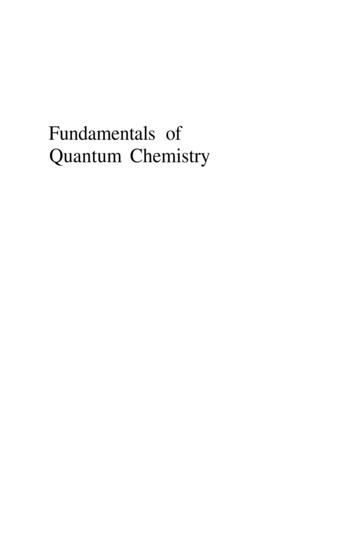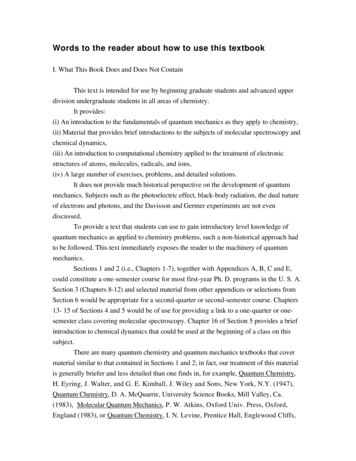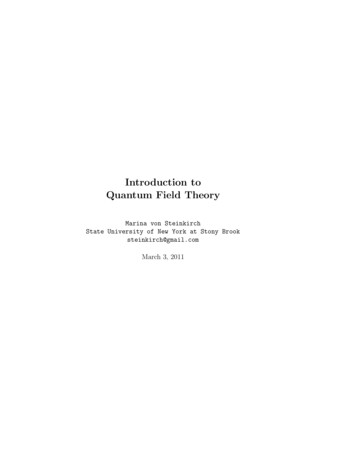
Transcription
Quantum ChemistryA concise introduction for students of physics, chemistry,biochemistry and materials scienceAjit J ThakkarDepartment of Chemistry, University of New Brunswick, Fredericton, CanadaMorgan & Claypool Publishers
Copyright ª Morgan & Claypool Publishers 2014All rights reserved. No part of this publication may be reproduced, stored in a retrieval systemor transmitted in any form or by any means, electronic, mechanical, photocopying, recordingor otherwise, without the prior permission of the publisher, or as expressly permitted by law orunder terms agreed with the appropriate rights organization. Multiple copying is permitted inaccordance with the terms of licences issued by the Copyright Licensing Agency, the CopyrightClearance Centre and other reproduction rights organisations.Rights & PermissionsTo obtain permission to re-use copyrighted material from Morgan & Claypool Publishers, pleasecontact info@morganclaypool.com.ISBNISBN978-1-627-05416-4 (ebook)978-1-627-05417-1 (print)DOI 10.1088/978-1-627-05416-4Version: 20140601IOP Concise PhysicsISSN 2053-2571 (online)ISSN 2054-7307 (print)A Morgan & Claypool publication as part of IOP Concise PhysicsMorgan & Claypool Publishers, 40 Oak Drive, San Rafael, CA, 94903, USA
ContentsPrefaceviii1Molecular symmetry1-11.1Symmetry operations and elements1.1.1 Rotations around axes1.1.2 Reflections through symmetry planes1.1.3 Inversion through a center of symmetry1.1.4 Improper rotations around improper axesClassification of molecular symmetryImplications of sic quantum mechanics2-12.12.2Wave functions specify a system’s stateOperators represent observables2.2.1 Operators2.2.2 Quantum chemical operatorsSchrödinger’s equationMeasured and average valuesProblems2-12-22-22-42-52-62-73Translation and vibration3-13.1A particle in a wire3.1.1 Solving the Schrödinger equation3.1.2 The energies are quantized3.1.3 Understanding and using the wave functionsA harmonic oscillator3.2.1 Molecular vibrationsProblems3-13-23-33-43-53-73-84Symmetry and degeneracy4-14.14.24.3A particle in a rectangular plateSymmetry leads to degeneracyProbabilities in degenerate states4-14-24-42.32.43.2v
Quantum Chemistry4.44.5Are degenerate wave functions unique?Symmetry of wave functionsProblems4-64-74-85Rotational motion5-15.15.2A particle on a ringA particle on a sphere5.2.1 Rotational wave functionsThe rigid rotor modelProblems5-15-45-65-75-86The hydrogen atom6-16.16.26.3The Born–Oppenheimer approximationThe electronic HamiltonianThe hydrogen atom6.3.1 Energy levels6.3.2 Orbitals6.3.3 Electron density and orbital size6.3.4 Spin angular momentumHydrogen-like ionsProblems6-16-26-36-46-56-66-86-96-97A one-electron molecule: H 27-17.17.27.37.47.57.6The LCAO modelLCAO potential energy curvesThe variation methodBeyond the LCAO modelForce constant and dissociation energyExcited statesProblems8Many-electron systems8-18.18.28.38.4The helium atomSpin and the Pauli postulateElectron densitiesThe Hartree–Fock model8.4.1 Matrix -97-10
Quantum Chemistry8.58.68.7AtomsDiatomic moleculesThe Kohn–Sham modelProblems9Qualitative MO theory9.19.29.39.49.59.6The H uckel modelCumulenesAnnulenesOther planar conjugated hydrocarbonsCharges, bond orders, and reactivityThe H uckel model is not ational chemistry10-18-78-98-118-139-110.1 Computations are now routine10.2 So many choices to be made10.2.1 Selection of a basis set10.2.2 Selecting a functional10.2.3 Heavy atoms and relativistic effects10.2.4 Accounting for a solvent10.3 Practical calculationsFurther eference materialA-1Matrices and determinantsMiscellaneousTable of integralsConversion factorsConstants and Greek lettersEquation listA-1A-2A-3A-4A-4A-5Problem hints and solutionsB-1vii
PrefaceAll chemists and many biochemists, materials scientists, engineers, and physicistsroutinely use spectroscopic measurements and electronic structure computations toassist and guide their work. This book is designed to help the non-specialist user ofthese tools achieve a basic understanding of the underlying concepts of quantumchemistry. The emphasis is on explaining ideas rather than on the enumeration offacts and/or the presentation of procedural details. The book can be used to teachintroductory quantum chemistry to second-or third-year undergraduates either as astand-alone one-semester course or as part of a physical chemistry or materialsscience course. Researchers in related fields can use the book as a quick introductionor refresher.The foundation is laid in the first two chapters which deal with molecular symmetry and the postulates of quantum mechanics, respectively. Symmetry is woventhrough the narrative of the next three chapters dealing with simple models oftranslational, rotational, and vibrational motion that underlie molecular spectroscopy and statistical thermodynamics. The next two chapters deal with the electronicstructure of the hydrogen atom and hydrogen molecule ion, respectively. Havingbeen armed with a basic knowledge of these prototypical systems, the reader is readyto learn, in the next chapter, the fundamental ideas used to deal with the complexities of many-electron atoms and molecules. These somewhat abstract ideas areillustrated with the venerable H uckel model of planar hydrocarbons in the penultimate chapter. The book concludes with an explanation of the bare minimum oftechnical choices that must be made to do meaningful electronic structure computations using quantum chemistry software packages.I urge readers who may be afraid of tackling quantum chemistry to relax. Rumorsabout its mathematical content and difficulty are highly exaggerated. Comfort withintroductory calculus helps but an open mind and some effort are much moreimportant. You too can acquire a working knowledge of applied quantum chemistryjust like the vast majority of students who have studied it. Some tips for studying thematerial are listed below.1. The material in later chapters depends on earlier ones. There are extensiveback references throughout to help you see the connections.2. Solving problems helps you learn. Make a serious attempt to do the end-ofchapter problems before you look at the solutions.3. You do need to learn basic facts and terminology in addition to the ideas.4. Study small amounts frequently. Complex ideas take time to sink in.This book grew from the quantum chemistry course that I have taught at theUniversity of New Brunswick since 1985. During the first few years of teaching it,I was unable to find a text book that treated all the topics which I taught in a way Iliked. So in the fall of 1994, I wrote a set of ‘bare bones’ notes after each lectureand distributed them during the next one. The encouraging and positive response ofthe students kept me going to the end of the course. Having arrived at a first draftviii
Quantum Chemistryin this manner, the bare bones were expanded over the next few years. Since then,this book has been revised over and over again using both explicit and implicitfeedback from students who have taken my course; it has been designed withtheir verbal and non-verbal responses to my lectures, questions, problems, and testsin mind.Fredericton31 March 2014Ajit J Thakkarix
IOP Concise PhysicsQuantum ChemistryA concise introduction for students of physics, chemistry, biochemistry and materials scienceAjit J ThakkarChapter 1Molecular symmetry1.1 Symmetry operations and elementsSymmetry is all around us. Most people find symmetry aesthetically pleasing.Molecular symmetry imposes constraints on molecular properties1. A symmetryoperation is an action that leaves an object looking the same after it has been carriedout. A symmetry element is a point, straight line, or plane (flat surface) with respect towhich a symmetry operation is carried out. The center of mass must remain unmovedby any symmetry operation and therefore lies on all symmetry elements. When discussing molecular symmetry, we normally use a Cartesian coordinate system with theorigin at the center of mass. There are five types of symmetry operation. The identityoperation E does nothing and is included only to make a connection between symmetry operations and group theory. The other four symmetry operations—rotationsCn, reflections σ, inversion i, and improper rotations Sn—are described next.1.1.1 Rotations around axesA symmetry axis Cn, of order n, is a straight line about which (1/n)th of a full ‘turn’(a rotation by an angle of 360! /n) brings a molecule into a configuration indistinguishable from the original one. A Cn axis must pass through the center of mass.A C1 axis corresponds to a 360! rotation and so it is the same as the identity operation: C1 ¼ E. A C2 axis has a 360! /2 ¼ 180! rotation associated with it. In H2O,HC2C2OOHHH1As Eugene Wigner said, symmetry provides ‘a structure and coherence to the laws of nature just as the laws ofnature provide a structure and coherence to a set of events’.doi:10.1088/978-1-627-05416-4ch11-1ª Morgan & Claypool Publishers 2014
Quantum Chemistrythe line bisecting the HOH angle is a C2 axis; rotation about this axis by 180! justinterchanges the two hydrogen nuclei. If the z axis is a C2 axis, then its action on anucleus is to move it from its original position (x, y, z) to (#x, #y, z). Thus32 3 2#xx76 7 6C2 ðzÞ4 y 5 ¼ 4 #y 5:zzð1:1ÞA C2 axis generates only one unique symmetry operation because two 180! rotationsbring an object back to its original configuration; that is, C2 C2 ¼ C22 ¼ E. Each ofthe objects A, B and C in figure 1.1 has exactly one C2 axis. The C2 axis is along thex axis in object A, along the y axis in object B, and along the z axis in object C. Themore symmetrical object D in figure 1.1 has three C2 axes, one along each of the x, yand z axes.A square has a C4 axis of symmetry as illustrated in figure 1.2. Performing twosuccessive C4 or 360! /4 ¼ 90! rotations has the same effect as a single C2 or 180!rotation; in symbols, C42 ¼ C2 . Hence for every C4 axis there is always a collinear C2axis. Moreover, C44 ¼ C22 ¼ E and so a C4 axis generates only two unique symmetryoperations, C4 and C43 . A clockwise C43 rotation is the same as a counter clockwiseyyABxxyyCDxxFigure 1.1. Can you see the C2 axes in objects A, B, C, and D?1-2
Quantum ChemistryabdacbC4dcC2C4bC4ccdbaC4adFigure 1.2. C4 symmetry in a square.C4 rotation. We adopt the convention that all rotations are clockwise. A C4 axis canbe found, for example, along each S–F bond in the octahedral molecule SF6, andalong the axial I–F bond in the square pyramidal IF5 molecule. (Tip: nuclei not onCn occur in sets of n equivalent ones.)In NH3, the line passing through the nitrogen nucleus and the center of thetriangle formed by the hydrogen nuclei is a C3 axis; rotation by 360! /3 ¼ 120! permutes the H nuclei ða ! b, b ! c, c ! aÞ. Methane has a C3 axis along eachC–H bond.HNHHHHCHHA C3 axis generates two unique symmetry operations, C3 and C32 . Benzene has a C6axis perpendicular to the ring and passing through its center. A C6 axis generatesonly two unique symmetry operations, C6 and C65 , because a C3 and a C2 axis arealways coincident with it, and C62 ¼ C3 , C63 ¼ C2 , C64 ¼ C32 , and C66 ¼ E. InO¼C¼O, the molecular axis is a C1 axis because rotation by any angle, howeversmall, about this axis leaves the nuclei unmoved.1-3
Quantum ChemistryThe z axis is taken along the principal symmetry axis which is defined as the Cnaxis with the highest order n. For example, the C6 axis is the principal axis inbenzene. If there are several Cn axes of the highest n, then the principal axis is the onepassing through the most nuclei. For example, ethene (C2H4) has three C2 axes andthe principal axis is the one passing through both carbons. A planar molecule thathas its principal axis in the molecular plane, like ethene but unlike benzene, is placedin the yz plane.HHC CHH1.1.2 Reflections through symmetry planesA plane is a symmetry plane σ if reflection of all nuclei through this plane sends themolecule into an indistinguishable configuration. A symmetry plane contains thecenter of mass and bisects a molecule. If the symmetry plane is the xy plane, thenits action on a nucleus is to move it from its original position (x, y, z) to (x, y, #z).Thus,2 3 23xx6 7 67σ xy 4 y 5 ¼ 4 y 5:z#zð1:2ÞA symmetry plane generates only one unique symmetry operation because reflectingthrough it twice brings a molecule back to its original configuration. Hence σ 2 ¼ E.A symmetry plane is also called a mirror plane.The xy plane is a symmetry plane for each of the planar objects A, B, C and D infigure 1.1. Objects A and D also have the xz plane as a plane of symmetry. Objects Band D have a yz symmetry plane. Object C has no other planes of symmetry. Thusobject D has three planes of symmetry, objects A and B each have two but object Chas only one plane of symmetry. Any planar molecule, such as benzene, has itsmolecular plane as a plane of symmetry because reflection across the molecularplane leaves all nuclei unmoved.NH3 has three planes of symmetry each of which contains an N–H bondand is perpendicular to the plane containing the three hydrogen atoms.(Tip: nuclei not on σ occur in equivalent pairs.) The three symmetry planes aregeometrically equivalent, and the corresponding reflections are said to form aclass. Operations in the same class can be converted into one another byapplication of some symmetry operation of the group or equivalently by asuitable rotation of the coordinate system. The identity operation always formsa class of its own.1-4
Quantum ChemistryA symmetry plane perpendicular to the principal symmetry axis is called ahorizontal symmetry plane σ h. Symmetry planes that contain the principal symmetryaxis are called vertical symmetry planes σ v. A vertical symmetry plane that bisectsthe angle between two C2 axes is called a dihedral plane σ d. The distinction betweenσ v and σ d planes is unimportant, at least in this book. For example, H2O has twovertical symmetry planes: the molecular plane and one perpendicular to it. Theintersection of the two planes coincides with the C2 axis. The molecular plane of aplanar molecule can be either horizontal as in C6H6 or vertical as in H2O. Benzenealso has six symmetry planes perpendicular to the ring and containing the C6 axis.These six planes separate into two classes: three containing CH bonds and threecontaining no nuclei. One class of planes is called vertical and the other dihedral; inthis example, either class could be called vertical. Linear molecules like HCl andHCN have an infinite number of vertical symmetry planes. Some of them, such asN2 and CO2, have a horizontal symmetry plane as well. Reflection in σ h is always ina class by itself.1.1.3 Inversion through a center of symmetryIf an equivalent nucleus is reached whenever a straight line from any nucleus to thecenter of mass is continued an equal distance in the opposite direction, thenthe center of mass is also a center of symmetry. Since the center of mass is at thecoordinate origin (0, 0, 0), the inversion operation i moves an object from its originalposition (x, y, z) to (#x, #y, #z). Thus2 3 23x#x6 7 67i4 y 5 ¼ 4 #y 5:z#zð1:3ÞObjects C and D in figure 1.1 have a center of symmetry but objects A and B donot. C6H6, SF6, C2H4 and the object in figure 1.3 have a center of symmetry but CH4Figure 1.3. This object has a center of symmetry. There would be no center of symmetry if the arrows pointedin the same direction.1-5
Quantum ChemistryσhC44321S4S42134S4Figure 1.4. A non-trivial S4 axis with no coincident C4 axis is shown for stacked erasers on the left and formethane on the right.does not. (Tip: nuclei not on i occur in equivalent pairs.) Inversion generates onlyone unique symmetry operation because i2 ¼ E. Inversion forms a class by itself.FFFSFFFHHC CHH1.1.4 Improper rotations around improper axesAn improper rotation Sn is a rotation by 360! /n about an axis followed by areflection in a plane perpendicular to the axis. Thus Sn ¼ σCn. No unique symmetryoperations are generated by an S1 or S2. Note that S1 ¼ σC1 ¼ σ because C1 ¼ E,and that S2 ¼ σC2 ¼ i as can be seen by combining equations (1.1)–(1.3). Henceonly Sn with n 3 are normally called Sn. Molecules which have both a Cn and a σ hmust have an Sn. For example, benzene has an S6 axis coincident with its C6 axisbecause it has a σ h.However, an object or molecule need not have a σ or a Cn to have an Sn. Nontrivial S4 axes are illustrated in figure 1.4 for a crossed stack of erasers and formethane. Figure 1.4 shows that methane has three S4 axes, each of which bisects twoHCH angles, even though it has neither a C4 axis nor any symmetry planes perpendicular to an S4 axis. An S4 axis generates only two unique symmetry operations,S4 and S43 , because S42 ¼ σC4 σC4 ¼ σ 2 C42 ¼ EC 2 ¼ C2 and S44 ¼ S42 S42 ¼ C22 ¼ E.1.2 Classification of molecular symmetryObjects cannot have an arbitrary collection of symmetry elements. For example, it isimpossible to have a molecule in which there is a C3 axis and only one σ v. A rotationby 120! about the C3 axis carries the σ v into a different plane, say P. Since C3 is asymmetry axis, this new configuration of the molecule must be indistinguishablefrom the original one. However, for this to be so, the plane P must be a σ v plane aswell. Clearly, a C3 axis and one σ v plane imply the existence of two more σ v planes.Mathematicians have worked out all possible groups of symmetry operations.Their results can be used to classify molecules by symmetry. Since all the symmetryelements of a molecule must intersect in at least one point, the symmetry groups are1-6
Quantum ChemistryLinear?Yesi?YesD hNoNoC v2 or more C5 ?Yesi?YesIhNoNoI2 or more C4 ?Yesi?YesOhNoNo4 C3 ?OYesσ?YesNoNoCn , n 1?TYes, n nmaxNoσ?NoC1YesThNoTdYesn C2 Cn ?σh ?NoYesCsNoi?i?σh ?Cinσv ?DnhNoYesCnhnσv ?NoYesYesYesDndNoNoYesCnvDnNoS2n ?YesS2nNoCnFigure 1.5. Flow chart for determining point group symmetry.called point groups. Each group is designated by a symbol called the Schoenfliessymbol.An atom has spherical symmetry and belongs to the K point group. To assign amolecule to a point group, use the flow chart given in figure 1.5. The first step is todecide whether the molecule is linear (all atoms on a straight line). If it is linear, then it1-7
Quantum ChemistryTable 1.1. Characteristic symmetry elements of point groups. n 2.SimpleC1CsCiSingle-axis groupsEσiCnCnvCnhDihedral groupsCnCn, nσ vCn, σ hDnDndDnhInfinite groupsC1vD1hKCn , nC 2 ð\Cn ÞCn , nC 2 ð\Cn Þ, nσ d , S2nCn , nC 2 ð\Cn Þ, nσ v , σ hPlatonic groupsC1 , 1σ vC1 , 1σ v , i, σ h1 C1TdOhIh4C3 , 3C2 , 6σ d , 3S43C4 , 4C3 , i, 6σ d , 3σ h6C5 , 10C3 , i, 15σhas C1v or D1h symmetry depending on whether or not it has an inversion center. Forexample, carbon dioxide (O¼C¼O) has D1h symmetry but HCN has C1v symmetry.If the molecule is not linear, then search for non-trivial axes of rotation Cn withn 1. It helps to know that if there is a Cn axis, then all the off-axis nuclei can beseparated into sets of n equivalent nuclei. If there are multiple Cn with n 2, thenthe molecule belongs to a high-symmetry ‘Platonic’ group. Six C5 axes indicate Ih,the point group of a perfect icosahedron or pentagonal dodecahedron, or the rare I,which has only the pure rotations of an icosahedron. Buckminsterfullerene C60 hasIh symmetry. Three C4 axes indicate Oh, the point group of a cube or a perfectoctahedron like SF6, or the rare O which has only the pure rotations of an octahedron. Four C3 axes and no C4 axes indicate Td, the group of a perfect tetrahedronlike methane, or the rare T which has only the rotations of Td, or Th obtained bycombining an inversion center with the rotations of T. The I, O, Th, and T pointgroups are chemically rare.If there are no Cn axes at all with n 1, the molecule is of low symmetry andbelongs to (a) Cs if there is a symmetry plane, (b) Ci if there is a center of inversion,and (c) C1 otherwise. If there are some Cn with n 1, choose a principal axis with themaximum n. From this point on, n is the fixed number that you determined in thisstep. Check for nC2 axes perpendicular to the principal axis of symmetry. Next, searchfor a horizontal plane of symmetry, σ h. Don’t assume that the molecular plane in aplanar molecule is a σ h. For example, the molecular plane in benzene is a σ h but themolecular plane in H2O is a σ v. On those rare occasions when you have to look for anS2n axis, bear in mind that 2n is always even and that 2n 4 because n 1. Moleculeswith Dn or S2n symmetry are uncommon. For example, C(C6H5)4 has S4 symmetry,and ethane in a conformation that is neither staggered nor eclipsed has D3 symmetry.Use table 1.1 to check for all the symmetry elements characteristic of the point group.Practice finding the point groups2 for the molecules in figure 1.6. Visualizationsoftware that allows rotation of a molecule’s ball-and-stick image in three dimensions is helpful. Newman projections, as taught in organic chemistry, help you seeDn, Dnd, and Dnh symmetry.2From left to right, first row: C1, Ci, Cs, C2; second row: C2v, C3v, C4v, C2h; third row: D2h, D3h, D6h, Oh;fourth row: D2d, D3d, Td.1-8
Quantum ChemistryBrHCClFClHHClBrHHHHFHFIFBCFFC CFFFHHFSFFFHHCFHFHCClFC CHFFHHHClNHClHCBrOHHHHHHHHCHHFigure 1.6. Molecules with various symmetries.1.3 Implications of symmetryThe dipole moment of a molecule should not be changed either in direction or inmagnitude by a symmetry operation. This invariance to symmetry operations can berealized only if the dipole moment vector is contained in each of the symmetryelements. For example, an inversion center, more than one Cn axis, and a horizontalsymmetry plane all eliminate the possibility of a dipole moment. Therefore, amolecule can have a non-zero dipole moment only if it belongs to one of the pointgroups C1, Cs, Cn or Cnv. Thus H2O with C2v symmetry can and does have anon-zero dipole moment, but CO2 with D1h symmetry cannot and does not havea non-zero dipole moment.A chiral molecule is one that cannot be superimposed on its mirror image. Thus, amolecule can be chiral only if it does not have a symmetry element that converts aright-handed object to a left-handed one. In other words, a molecule can be chiralonly if it does not have a plane of symmetry or an inversion center or an improperaxis of symmetry Sn. Since S1 ¼ σ and S2 ¼ i, we can simply say that the presence ofan improper axis of symmetry rules out chirality. A molecule can be chiral only if itbelongs to a Cn or Dn point group.In discussions of rotational spectroscopy, it is usual to classify molecules into fourkinds of rotors or tops. The correspondence between that classification and pointgroups is simple. Linear rotors are C1v or D1h molecules. Spherical tops containmore than one Cn axis with n 3 as in Td, Oh or Ih molecules. Symmetric tops aremolecules that contain one and only one Cn axis with n 3 or an S4 axis, and thusbelong to Cn, Cnv, Cnh, Dn, Dnh or Dnd with n 3 or D2d or Sn ðn ¼ 4, 6, 8, . . .Þ.1-9
Quantum σvC32 C3 1Figure 1.7. Non-commutativity of reflections in an equilateral triangle.Asymmetric tops are molecules that do not contain any Cn axis with n 3 or S4 axis,and thus belong to C1, Ci, Cs, C2, C2v, C2h, D2 or D2h.Two symmetry operations, O1 and O2 , are said to commute if the result of carrying out one after the other does not depend upon the order in which they arecarried out. That is O1 and O2 commute if O1 O2 ¼ O2 O1 where O1 O2 means first doO2 and then do O1 . Symmetry operations do not always commute. For example,figure 1.7 shows that, in an equilateral triangle, reflections in the σ v do not commutewith one another; in symbols, we write σ 0v σ v 6¼ σ v σ 0v . Figure 1.7 also shows thatσ 0v σ v ¼ C3 and σ v σ 0v ¼ C32 .Groups in which each symmetry operation commutes with every other symmetryoperation are called Abelian. Every element of an Abelian group forms a class byitself. Note that the symmetry group of an asymmetric top molecule is always anAbelian point group. The energy levels of molecules with Abelian symmetry have aspecial simplicity as we shall see in section 4.2.Problems (see appendix B for hints and solutions)1.1 Which of the molecules in figure 1.6 has a center of inversion?1.2 Suppose the z axis is a C4 axis of symmetry. What will be the coordinates of anucleus after a clockwise C4 rotation if its coordinates were (x, y, z) before therotation?1-10
Quantum Chemistry1.3 Use sketches to show all the symmetry elements in naphthalene.1.4 Use sketches to show all the symmetry elements in the following molecules:1.5 Find two planes of symmetry and three C2 axes in allene (C3H4).HHCCCHHUse sketches to show the symmetry elements. Drawing Newman diagrams (projections) in the manner of organic chemistry books is helpful.1.6 Find the symmetry point group for each of the following molecules. Whichmolecules are polar and which are chiral?HHNHHHHHHBNNBBNHHHClClFHHSnHClCl1.7 Find the symmetry point group for each of the following molecules. Whichmolecules are polar and which are chiral?HHCFF1.8 A molecule has three C2 axes that are perpendicular to each other, and no othernon-trivial symmetry elements. Can such a molecule have a non-zero dipolemoment? Can it be chiral? Explain without reference to the point group of themolecule.1-11
IOP Concise PhysicsQuantum ChemistryA concise introduction for students of physics, chemistry, biochemistry and materials scienceAjit J ThakkarChapter 2Basic quantum mechanics2.1 Wave functions specify a system’s stateNewton’s laws do not describe correctly the behavior of electrons in molecules; instead,quantum mechanics is required. Following early foundation work by Max Planck,Albert Einstein, Niels Bohr, and Louis de Broglie, modern quantum mechanicswas discovered in the 1920s, primarily by Werner Heisenberg, Max Born, ErwinSchrödinger, Paul Dirac, and Wolfgang Pauli. All nine won Physics Nobel Prizes.The justification for quantum mechanics is that it provides an accurate description of nature. As Bohr said, ‘It is wrong to think that the task of science is to findout how Nature is. Science concerns what we can say about Nature.’In quantum mechanics, the state of a system is completely specified by a functioncalled the time-dependent state or wave function. It is a function of the time t, and ofthe three position coordinates of each of the particles in the system. A system whichis not subject to time-varying external forces can be described by a time-independentwave function ψ (read ψ as sigh), which is a function of the position coordinatesbut does not depend on the time. In this book we focus exclusively on such systems.Hence, all wave functions will be time-independent unless explicitly stated otherwise.For example, the wave function of a one-particle system can be written as ψ(x, y, z)where (x, y, z) are the Cartesian coordinates of the position of the particle. The wavefunction contains all the information that can be known about the system. MaxBorn’s interpretation of the wave function is that jψj2 is a probability density. Thus,for a one-particle system, the probability that the particle is in a tiny box centered at(x, y, z) with sides dx, dy, and dz is given by jψðx, y, zÞj2 dx dy dz, where dx dy dz iscalled the volume element1.1The probability density jψj2 is real and non-negative, as it must be, even if the wave function ψ is complexvalued. In that case, jψj2 ¼ ψ * ψ where the asterisk denotes complex conjugation; appendix A has a briefreview of complex numbers. In this book, we will work only with real-valued wave functions, and so jψj2 willbe the same as ψ 2.doi:10.1088/978-1-627-05416-4ch22-1ª Morgan & Claypool Publishers 2014
Quantum ChemistryTo ensure that the sum of the probabilities for finding the particle atR all possiblelocations is finite, the wave function ψ must be square-integrable: jψðx, y, zÞj22dx dy dz 1. For example, ψ ¼ e x is square-integrable over 1 x 1 but2ψ ¼ eþx is not.e x22e x00xxProbabilities are usually expressed on a scale from 0 (no chance) to 1 (certainty).The certainty that the particle is somewhere leads to the normalization condition forthe wave function:Zjψðx, y, zÞj2 dx dy dz ¼ 1:ð2:1ÞClearly, the wave function must be continuous for it to yield a physically sensibleprobability density. All this is summarized in:Postulate 1. The state of a system not subject to external time-varying forces is specifiedcompletely by a continuous and square-integrable wave function ψ that depends onthe coordinates of the particles. The quantity jψj2 dτ is the probability of finding theparticles in a volume element dτ at a given location.2.2 Operators represent observablesIn quantum chemistry, every physical observable is represented by an operator.Hence, we first study operators and then quantum chemical ones.2.2.1 OperatorsA function of one variable, like sin(x), is a ‘black box’ that takes any real number xas input and produces a real number as output. Similarly, an operator is a black boxthat takes a function (or vector) as input and produces a function (or vector) asoutput. For example, the differentiation operator d/dx takes the function sin(x) asinput and produces the function cos(x) as output. A ‘hat’ may be used to indicatethat a symbol represents an operator; for example, A fðxÞ ¼ gðxÞ indicates that theoperator A maps the function f(x) on to the function g(x).We have already encountered, in equations (1.1)–(1.3), the symmetry operatorsC2 , σ xy and i, which map a vector containing the Cartesian coordinates of a point toa vector containing the coordinates of the location to which the point is moved bythe corresponding symmetry operation. A symmetry operator can act on a functionby changing the arguments of
introductory quantum chemistry to second-or third-year undergraduates either as a stand-alone one-semester course or as part of a physical chemistry or materials science course. Researchers in related fields can use the book as a quick introduction or refresher. The foundation is lai










